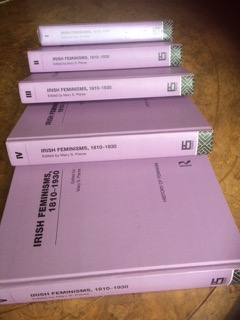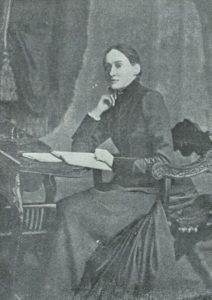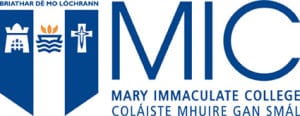A Case for Editorial and Curatorial Interventions
Anna Pilz & Whitney Standlee, Network Team
In the papers of Katharine Tynan Hinkson held at the John Rylands Library in Manchester is a strongly worded letter from 1902 that attests to the difficulties that tend to assail the editors of volumes of literature. The letter in question is from Tynan’s fellow Irish writer George Egerton (Mary Chavelita Dunne), and was written to raise objections to the selection of Egerton’s works that Tynan was seeking permission to include in The Cabinet of Irish Literature, a four-volume anthology of Irish writing she was re-editing and expanding at that time. ‘I do not think it would be fair to me to merely give an extract from my first book “Keynotes,”’ Egerton wrote, ‘as that conveys the impression, in a measure, that I have not done any work equal to it […] I am willing to be represented by an extract from Keynotes and one from Rosa Amorosa.’[1] The volumes that Tynan eventually produced are remarkably varied and inclusive, and perhaps most noteworthy for the fact that they (as is noted on the title page) were ‘greatly extended by Katharine Tynan Hinkson’. Those extensions primarily consisted of introducing additional and more diverse women’s writing into the mix, but also clearly involved a measure of compromise: it is indeed one selection from Egerton’s Keynotes and another from Rosa Amorosa that appear in the final compilation.
Our own recent interview with Mary S. Pierse concerning her similar (but hopefully far less contentious) act of editing and retrieval for her five-volume series on Irish Feminisms, 1810-1930 started us reflecting on the importance of these interventions more generally. To paraphrase Jane Austen, it is a truth universally acknowledged that research into Irish women’s writing is marked by an attention to invisibilities, gaps, and omissions. A key strand of feminist literary scholarship is, therefore, recovery work: making visible the diversity and extent to which women writers were and continue to be an imperative part of the republic of letters. Bringing into focus previously overlooked and understudied texts is a collaborative project between scholars, publishers, editors, and – of course – readers (of both the general and expert kind). More than simply reproducing a text that has gone out of print, scholarly editing also involves engaging with and retrieving women writers’ private thoughts, working practices, family lives and cultural milieus: these are acts of bringing together fragmented and scattered archival sources that range from correspondence with publishers, contemporaries, and family members to manuscript drafts of poems or novels (if they have survived), as well as biographical information and intertextual and extratextual references that open up wider debates and avenues of research.

‘Exhibition space of ‘All This Mine Alone: Lady Gregory and the Irish Literary Revival’ at the New York Public Library, March 2020.’ Copyright: Barry Houlihan.
In terms of the literary history of Irish women writers, we can draw on three developments that have increased the visibility of texts and archival collections: scholarly editions of individual or collections of texts in print, exhibitions, and the opportunities afforded by digital collections. Exhibitions are a relatively new phenomenon in Irish women’s literary history, and are essential mediations into the act of drawing the attention of the general public to women writers about whom most people knew very little or nothing at all. At the same time, exhibitions remind scholars that there are additional and important works of literature to be revisited and explored.
A notable example of this process of curatorial introduction and revisiting is the first exhibition devoted to playwright and co-founder of the Abbey Theatre Lady Augusta Gregory at the New York Public Library, a venue not only prominent in terms of reputation but also location: it is situated in the heart of Manhattan by Bryant Park on buzzing Fifth Avenue. Titled ‘All This Mine Alone: Lady Gregory and the Irish Literary Revival’, it launched in early March and will see a renewed opening in October, due to the interruption caused by COVID-19. Curated by Gregory specialist James Pethica and novelist/academic Colm Tóibín, international research on the exhibition stemmed from various archive collections, including NYPL’s Berg collection, the Abbey Theatre Digital Archive and the Colin Smythe Collection at the Hardiman Library, NUI Galway. It is described by the NYPL as not only the ‘first major exhibition of her work’, but also as a project which foregrounds ‘her creative evolution and independent achievements, along with her influence on others’. As such, it is perhaps the most prominent of many welcome ongoing interventions into Gregory’s literary legacy. Its importance lies in the fact that it, like some recent scholarship, prioritises her work – literary, managerial and philanthropic – over her facilitation of the work of others (who famously included W. B. Yeats and J. M. Synge). Addressing such overshadowings and occlusions, the exhibition showcases little seen excerpts from Gregory’s diaries and the manuscript of Cathleen ni Houlihan among a number of other items that attest to her cultural significance.
These types of staged events that include physical objects remind us that Gregory is not just words on a page, not just a facilitator of others, but an important literary personality in her own right. In other words, the exhibition allows us to view Gregory stepping out of the shadow of Yeats and Synge, and into the limelight.

Indeed, the launch event deliberately coincided with an off-Broadway production by the Irish Repertory Theatre of the play Whisperings of Lady G – which, as a compilation of excerpts from letters and plays with additional material written by Ciarán O’Reilly, and including performances of Gregory’s short plays Workhouse Ward and McDonough’s Wife – also constitutes an act of editing.
Coupled with efforts to bring Gregory’s work back to the stage, acts of curatorial intervention like these are imperative to building the momentum of scholarly interest in and public enthusiasm for Gregory and her works. The commitment by a world-leading institution such as the NYPL to making her work visible to and accessible by a wider, younger, more politically and culturally engaged audience/readership has already fostered transnational collaborations between artists and scholars, and will likely continue to instigate various creative transnational alliances for years to come. It is therefore not only admirable, but necessary.

And it is not the only one of its kind: the Músaem Litríochta na hÉireann/Museum of Irish Literature in Dublin used its public space from its opening in September 2019 to place another Irish woman writer in the spotlight.[2] Its inaugural exhibition, Kate O’Brien: Arrow to the Heart, curated by O’Brien’s grand-niece Kathy Rose O’Brien, invited visitors to ‘take a seat in the window and listen to Kathy Rose read extracts from the work of Kate O’Brien, or see her perform an exchange of letters in the video on the wall’. This exhibition creatively brought to light the more personal aspects of O’Brien’s work and was an act of intergenerational recovery.
In both cases the possibility for these exhibitions relied on the existence of materials (textual, visual, objects) that could be put on display. In the instance of Lady Gregory, the archival collections of drafts of plays, letters, notebooks, scrapbooks, typescripts of lectures and photographs seem a bottomless pit and treasure trove. This leads to a further consideration: the ongoing and perhaps unavoidable association between literary status and social position. This is particularly pronounced in terms of women writers, because for much of history (both within and outside of Ireland) a woman’s social status and her access to both education and to the public sphere were inextricably intertwined. The result is that, if a woman writer belonged to a family with political and cultural standing or had links to a landed estate, the likelihood of an expansive and extant collection of papers and other personal artefacts increases. In researching other women writers, especially those whose social and professional statuses were not so elevated or secure as Gregory’s, many of us cannot rely on neatly collated and archived family papers held at one or two institutions. Materials can be and often are scattered (as both Tynan’s and Egerton’s are) in publishers’ archives, in more prominent writers’ papers, in private possession, or simply non-existent. In those cases, the printed written words are the key sources available. And here, too, sources have to be located across various newspapers and periodicals, were published anonymously or pseudonymously – can be, in other words, very tangled webs to unweave.
The Field Day Anthology of Irish Writing volumes 4 and 5 were a crucial project in recovery work that reintroduced and reframed a variety of writers and texts from the past for the present moment.[3] Considering the initial stir caused by volumes 1 to 3, the two subsequent volumes dedicated to women’s writing were and remain highly visible in Irish Studies scholarship. Most students of Irish literature will have encountered them along their studious path, and it is to these volumes that we can point as both an encouragement and enabler of a growing corpus of research into female authors of the 1880-1920 period over the past eighteen years. These authors include Annie Besant, George Egerton, Dora Sigerson Shorter, Rose Kavanagh, Katharine Tynan, Rosa Mulholland, Emily Lawless and Katherine Cecil Thurston. And it should be acknowledged that works such as The Field Day Anthology owe much to earlier collections, including those compiled by Tynan and Stephen J. Brown, whose Ireland in Fiction (1919) is, like Tynan’s effort, a remarkable act of inclusion and reclamation. Where readily accessible sources and archives do not exist, however, research can also be misguided and/or limited by early edited works such as those compiled by Tynan and Brown. Errors and exclusions tend to inhere.
Pierse’s five-volume series on Irish Feminisms, 1810-1930 includes facsimiles of an assortment of writings by authors of various sexual and gendered identities in a range of genres which extend and solidify these types of retrieval efforts. As E. Moore Quinn’s 2012 review of the collection for the Irish Literary Supplement notes, ‘one can say unequivocally that students of Ireland now possess the opportunity to see these remarkable documents as well as to study them as they appeared in their original formats; such a boon enriches the entire field of Irish scholarship.’ Alongside Tynan, Pierse incorporates writings by Hanna Sheehy Skeffington, Constance Markievicz, Alice Stopford Green, Rosamond Jacob, C. Máire Ní Dhubhghaill, Fanny Parnell, Frances Power Cobbe, Anna S. Haslam, Rosa Mulholland, Grace Plunkett, Dora Sigerson, Maud Gonne, Eva Gore-Booth, and Alice Furlong. And it must be said that things have moved on exponentially since then: so many more works and documents have now been digitised and made available online, and remain to be rediscovered and re-examined.
Yet access to sources remains a problem, and continues to be (like the survival of historical documents) largely an issue of privilege. Richer universities and those employed at them enjoy the ability to make use of much more generous library budgets and thus a wider and more diverse collection of primary and secondary sources. Databases such as British Periodicals Online, the British Newspaper Archive, or access to the Irish Times, for instance, are not uniformly available to all scholars at all institutions. Researching in the era of a global pandemic only exacerbates these types of problems for researchers of more limited means and resources, who often are forced to rely on networks of friends and colleagues at more ‘prestigious’ institutions to provide them with materials. With travel restrictions in place and libraries and archives closed or operating at limited capacity for personal visits, we are relying more than ever on what is available to us digitally. It is admirable that academic presses such as Johns Hopkins University and databases like JSTOR and Project Muse have made their holdings freely available to those who would otherwise have little or no access to them in order to facilitate research, teaching, and learning in these unprecedented times. Yet much more needs to be done to level the academic playing field.

It is a shame, for instance, that Pierse’s volumes remain difficult to access a decade after their publication. At a price of £1,005, the five volumes leave deep holes in library pockets. And if one were to want to access the volumes now in Ireland, the UK or Germany, for instance, they are likely shelved in the reference section of an institutional library, with no loan options. Surely, a case can be made to offer Irish Feminisms as an affordable e-publication that could be included in Routledge’s subscription options: a decade on, sales of the volumes cannot be brisk, and a digital copy would not only be advantageous to students and researchers, but to Routledge, too.
There is indeed much editing and recovery that remains to be done, and Irish women writers present one of the richest and most varied seams of research still to be mined. It is hoped that the work and the funding of the near future will facilitate the excavation of more works. The digital humanities offer unique opportunities for more democratic access on the one hand, and for additional facilitation of intertextualities and other forms of content-connectedness. For now, though, we can dream of an ideal database; imagine a world in which one could delve into the rich editorial work already done on Irish women writers between 1880 and 1920 in the ‘Archives’ section of this webpage and click one’s way through – say – Egerton or Tynan – and be instantly brought to digitised versions of Field Day, Loeber and Stouthamer-Loeber’s Guide to Irish Fiction, and Pierse’s Irish Feminisms. As is the case with any editorial intervention, the realisation of this type of project – of this type of dream – relies on a collective effort of stakeholders that includes institutions, editors, publishers, readers – and, of course, sources of funding.
To reference this blog:
Harvard style:
Pilz, Anna and Standlee, Whitney (2020), ‘A Case for Editorial and Curatorial Interventions’, Irish Women’s Writing (1880-1920) Network Blog [online], 29 July 2020, Available at: https://irishwomenswritingnetwork.com/2020/07/30/a-case-for-editorial-and-curatorial-interventions/ (Accessed: Date)
In text: …Pilz and Standlee (2020)…
If you would like to submit a blog contact Dr Deirdre Flynn and check our guidelines here.
[1] Katharine Tynan Hinkson Papers, John Rylands Library, GB 0133 KTH Box 3/11 – Letter to Katharine Tynan from George Egerton dated 4 February 1902
[2] On the potential and impact of such exhibitions at the Museum of Irish Literature, read Margaret Kelleher’s interview in the Research Pioneer series.
[3] Read more on the Field Day volumes 4 and 5 project in our interview with one of the editors, Gerardine Meaney.
A Case for Editorial and Curatorial Interventions
Tweet



